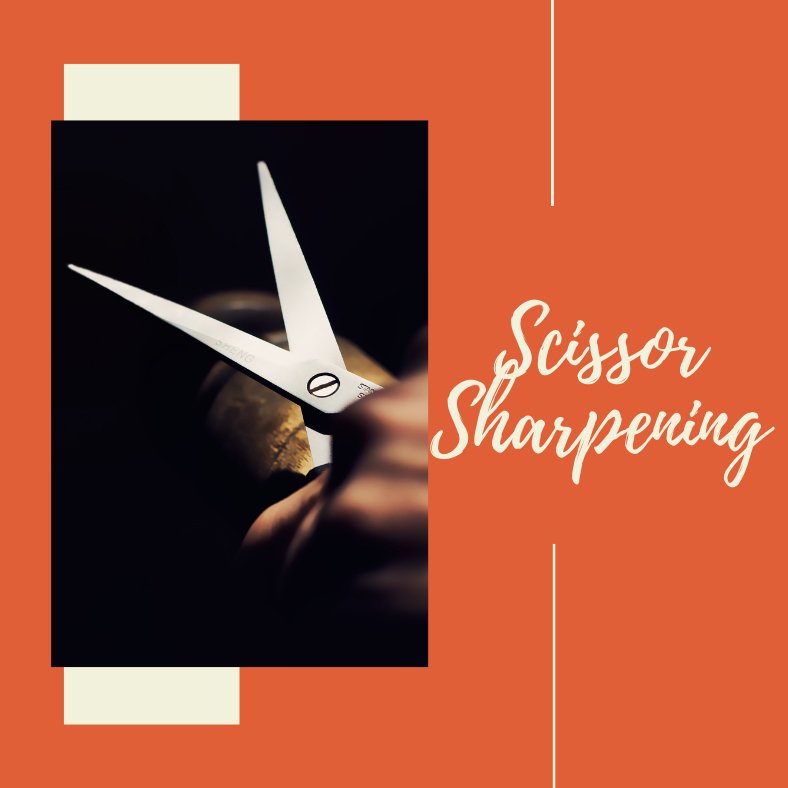scissor sharpening service
Next Date: November 15, 2021
Are your sewing scissors sharp? A dull pair of scissors can lead to hand cramps, imprecise cuts and wasted fabric. We can’t stress enough how important it is to have your scissors sharpened by a professional!
We hold regular scissor sharpening days with a qualified metal worker who has 24 years’ experience in sharpening scissors, knives and tools to get your scissors back in shape.
Here’s how it works
1. Drop off your scissors (knives and garden tools are welcome too) at the studio before the sharpening day.
2. Attach a tag with your name and phone number on the handle of each piece.
3. Include the amount payable in a envelope, together with your items to be sharpened.
4. Collect your pieces and any refund due (if a piece is unsuitable for sharpening).
5. If, for any reason, your item can’t be sharpened (some scissors are not good candidates), we will return your item and payment
prices
SCISSORS AND GARDEN TOOLS: $15 per item
KNIVES: $12 per item
Things to keep in mind
Scissors with one serrated blade will have the serrated blade cleaned and the straight blade sharpened. If the serrated blade is blunt, nicked or damaged it can be ground away so you get the maximum life out of the scissor.
Pinking shears are a little trickier to sharpen, so these will be assessed on the day and taken away for sharpening.
How to choose scissors
Make sure the scissors are comfortable in your hand – this is the most important consideration.
Buy scissors designed for the job. There are scissors with small sharp points for thread cutting and clipping, duck-billed configurations for applique and scissors with one finely serrated blade for cutting slippery or fine fabrics. Scissors with longer blades and a shaped handle (so the scissor is perpendicular to the table and one edge rests on the table when cutting) are called shears and are used by dressmakers and tailors to cut wools and woven fabrics.
Use your scissors to cut only the fabric that they’re designed for. Lycra, microfiber, polyester and some man-made fabrics blunt scissors quickly, so it’s a good idea to have scissors for cutting these fabrics.
Scissors (like knives) are inlaid, hardened and toughened to produce cutting surfaces that stay sharper longer and this process accounts for the difference in price. Treatments like Teflon are more faddish and tend to come off quite quickly when used on fabric so they’re not generally advisable for sewing or dressmaking.
Maintaining your scissors
Keep scissors in a sheaf if it’s provided.
Store scissors separately so the blades do not get damaged or nicked.
Avoid humidity as it can cause surface rust.
When cutting, be aware of pins as nicks can ruin your scissors. Even if the nick can be ground out, you may lose a large amount of your blade and shorten the life of your scissors.
Don’t cut paper with fabric scissors. Your mother was right: paper blunts scissors!
Wipe scissors with a soft, damp cloth and allow to dry. A little WD-40 may be used to lubricate your scissors if the blades are stiff.
Keep your blades sharp.
Specialty scissors for dressmaking
Paper-cutting scissors
Fabric scissors or shears with one serrated blade for fine, slippery fabrics. These should have a shaped handle so they stay perpendicular to the table and rest on the table when cutting. Buy the longest blade length that you can comfortably hold.
Fabric scissors or shears with two sharpened blades for woven fabrics. These should also have a shaped handle so they stay perpendicular to the table and rest on the table when cutting. Again, longest blade length that you can comfortably hold.
A small pair of pointed scissors for cutting thread, clipping seam allowances and button holes.
Optional scissors
A straight handled scissor with a large hand grip and a medium pointed blade for draping.
Duck-billed scissors for trimming excess seam allowances on fine hems and decorative finishes.
A separate pair of scissors for man-made fabrics that blunt scissors quickly.
Pinking shears for edging seam allowances.

